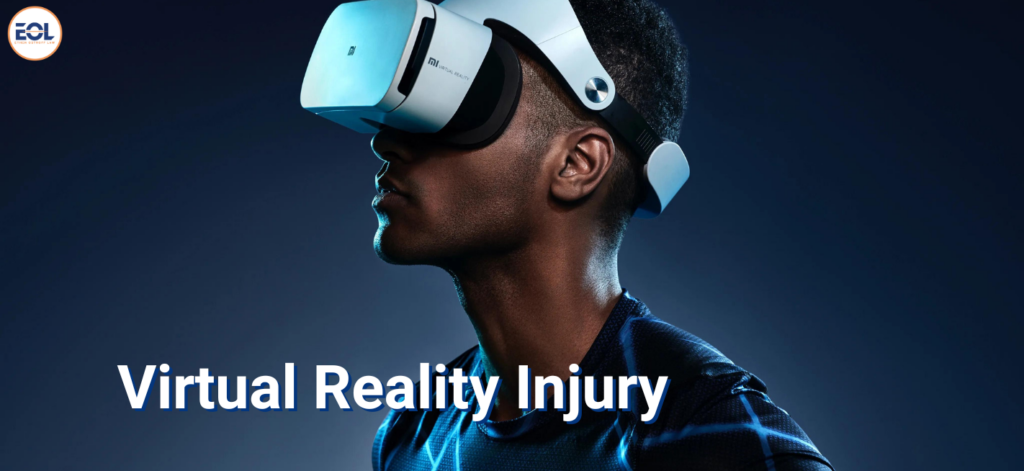Virtual Reality Injury Lawsuit Essentials in 2024
The advent of virtual reality (VR) technology has reshaped our digital interactions, ushering in immersive landscapes that blur the lines between the real and the simulated. At the heart of this transformation lie VR headsets. Equipped with state-of-the-art sensors and displays, these devices meticulously track users’ movements, tailoring the visual experience to their every gesture. They’re popular in gaming, education, and more. But as VR grows, so do the risks. Users can get hurt—tripping over things, feeling eye strain or headaches, or even psychological effects like anxiety. If you’re injured while using VR, you might consider filing a virtual reality injury lawsuit. Here, Ethen Ostroff Law explains VR injuries, what to do if you’re hurt, and how a metaverse injury lawyer can assist you.
What is Virtual Reality?
Virtual reality (VR) is advanced tech that makes a pretend world feel super real. With VR headsets—special goggles with sensors and screens—users dive into 3D worlds and feel like they’re actually there. These goggles track your head movements and show visuals that make you feel fully immersed, unlike regular screens.
How Do VR Headsets Work?
VR headsets create immersive experiences by combining hardware and software:
- Audio: They use 3D spatial audio for sounds from all around, boosting immersion.
- Controllers: These handheld devices track hand movements for interaction.
- Displays: High-res screens near the eyes offer a wide field of view.
- Sensors: Inside are accelerometers, gyroscopes, and sometimes external sensors for realistic head movement tracking.
Who Uses VR?
As VR technology advances and becomes more accessible, its popularity continues to soar across various sectors, including:
- Education: Facilitates virtual field trips and interactive learning modules.
- Gaming: Renowned for delivering immersive gameplay experiences.
- Healthcare: Utilized for training medical professionals and therapeutic interventions.
- Professional training: Offers realistic simulations for industries such as aviation and the military.
- Social interaction: Enables users to congregate in virtual spaces within the metaverse for events and socializing.

Prevalence of VR Injuries
A 2023 study by Dignity Health researchers in Arizona analyzed US emergency room data and found that the first recorded VR injury occurred in 2017. By 2021, there were approximately 1,336 reported injuries related to VR technology. Common injuries among VR users include broken bones, cuts, contusions, and sprains. Risks such as tripping over objects and disorientation from head movements often lead to falls and other accidents in the virtual world.
What Are the Damages of Virtual Reality?
VR offers immersive experiences, but it also poses risks that can lead to various types of damage. Here’s a breakdown:
Financial Damages
- Equipment damage: Repairs or replacements for damaged VR gear can be costly.
- Lost wages: Injuries may lead to missed work and reduced earning capacity.
- Medical expenses: Injuries can result in significant medical bills.
Long-term Health Issues
- Postural problems: Improper VR posture may cause back, neck, or shoulder pain.
- Vision problems: Prolonged VR exposure may impact vision, though research is ongoing.
Physical Injuries
- Eye strain and fatigue: Extended VR sessions can lead to eye strain, headaches, and fatigue.
- Falls and collisions: Users may trip or bump into objects, resulting in bruises, fractures, or concussions.
- Repetitive strain injuries (RSIs): Continuous controller use can cause strain on hands, wrists, or arms.
Psychological Effects
- Anxiety and stress: Intense VR experiences can trigger anxiety or stress reactions.
- Desensitization: Exposure to intense VR content may desensitize users emotionally.
- Motion sickness: VR can cause symptoms like dizziness and nausea due to visual-physical motion disparity.
Social and Behavioral Impacts
- Behavioral changes: VR may affect real-world behavior.
- Isolation: Excessive VR use can lead to social isolation.
What Is the Most Common Injury in VR?
Virtual reality is revolutionizing digital interactions, offering immersive experiences in gaming, education, healthcare, and beyond. Yet, as VR headset usage grows, so does the incidence of associated injuries. Common ones include:
- Broken bones: Especially when caution is lacking or due to defective headsets.
- Concussions: Resulting from collisions or falls while wearing the headset.
- Disorientation: Leading to accidents.
- Eyestrain: Occurring with prolonged VR use.
- Lacerations: Caused by collisions with objects or individuals.
- Muscle strains and tears: Due to incorrect usage.
- Neck strain: Arising from improper headset adjustment.
- RSIs: From repetitive movement using VR equipment.
- Seizures: Particularly in individuals with photosensitive epilepsy.
How Do VR Injuries Happen?
VR injuries have become common since the first VR devices were introduced. As VR technology advances and becomes more popular in homes, the risk of injuries increases. Here’s how they happen:
- False sense of reality: VR’s realistic nature can create a false sense of safety, causing users to take risks they wouldn’t normally take, such as jumping or running.
- Immersion and disconnection: Users often forget about real-world objects and people around them, leading to collisions, trips, and falls.
- Inadequate space: Using VR in a confined or cluttered space increases the risk of tripping over or bumping into objects, leading to injuries.
- Motion sickness: The difference between visual motion in VR and physical motion in the real world can cause motion sickness, leading to dizziness, nausea, and disorientation, which can result in accidents.
- Prolonged use: Extended VR use can cause physical strain from continuous use of controllers.
By understanding these risks, users can take steps to minimize injuries.
What Are the Best Practices for Setting Up a Safe VR Environment?
To set up a safe VR environment, follow these best practices:
- Avoid VR if you have epilepsy, balance issues, or motion sickness.
- Create a safe environment by clearing the area of obstacles and hazards. Remove sharp objects and use VR while sitting unless the program requires standing or walking.
- Familiarize yourself with the space by walking around before starting. Ensure an open space to avoid collisions.
- Follow the manufacturer’s instructions for proper use and maintenance of the headset.
- Have a spotter to ensure you stay safe in the real world while using the headset.
- Limit VR sessions to 20 minutes to prevent disorientation and simulator sickness. Take breaks every 30 minutes to avoid eye strain and fatigue.
- Monitor your body for discomfort, such as headaches or eye strain, and stop if you experience any. Adjust focal settings to prevent eye strain.
- Sanitize the parts of the VR headset that touch your face between users and clean the headset regularly.
- Start with a simple program to avoid overwhelming yourself.

What Are the Legal Issues with Virtual Reality?
VR brings exciting new ways to interact with digital environments but also presents various legal challenges. Key legal issues include:
- Accessibility and discrimination: VR environments must avoid discrimination based on race, gender, disability, or other protected characteristics. They need to be accessible to people with disabilities to comply with legal requirements or risk lawsuits.
- Contractual issues: VR platforms must navigate complex licensing agreements for third-party content and software. User agreements with VR providers need to be transparent about user rights and responsibilities.
- Intellectual property: Ownership and protection of intellectual property in VR are intricate due to digital content creation and sharing. Copyright infringement is a concern in VR environments.
- Jurisdiction and enforcement: Determining applicable laws and enforcing them is complicated with VR users and providers spread across different jurisdictions. Rapid VR development often outpaces existing laws, resulting in legal uncertainties.
- Privacy and data security: Protecting extensive user data collected by VR from unauthorized access and misuse is crucial. Users must be fully informed about data collection and provide consent to avoid legal complications.
- Product liability: VR manufacturers may face liability for injuries stemming from design flaws, manufacturing defects, or inadequate instructions. VR software developers could also be held responsible for harm caused by bugs or poor design.
- User safety and health: Increasing incidents of VR-related injuries can result in legal issues, particularly if caused by product defects or inadequate safety measures. Developers must caution users about potential anxiety or motion sickness risks.
What to Do If You Are Injured in a Metaverse Environment
Getting injured in a metaverse with a VR device can be disorienting. But act promptly to safeguard your health, preserve evidence, and strengthen your case if you decide to sue. Here’s what you must do:
- Seek medical attention immediately: Even seemingly minor injuries should be assessed to ensure proper documentation for potential legal proceedings.
- Document the incident: Immediately jot down details of the incident, including the date, time, virtual environment, activities performed, and how the injury occurred. Taking photographs of injuries and relevant equipment is also crucial for preserving evidence.
- Preserve evidence: Keep the VR equipment intact and refrain from repairing or disposing of it. Additionally, collect witness statements from anyone present during the incident to further substantiate your case.
- Report the incident: Notify the VR headset manufacturer and the platform provider or game developer, if applicable, about the injury. Following their procedures ensures a record of your report and potential investigation.
- Consult a metaverse injury lawyer: Seek legal advice from a lawyer specializing in metaverse and VR-related injuries.
What Are Your Legal Options When You Have VR Injuries?
If you’ve sustained injuries in a VR environment, seeking legal advice is crucial. Here are your main legal options:
- Class action lawsuits: Consider joining a class action lawsuit if multiple individuals have similar injuries from the same VR headset model. This collective approach allows pooling resources for legal action against the manufacturer.
- Personal injury lawsuits: For severe or unique injuries, filing a virtual reality injury lawsuit may be necessary. This allows for a tailored legal strategy to address your specific circumstances, seeking compensation for various losses such as medical expenses and lost wages.
- Seeking legal assistance: Connect with a lawyer specializing in product liability and personal injury cases to understand your options and pursue the best legal course. They’ll increase your chances of obtaining fair compensation while focusing on your recovery.
What Are the Legal Grounds for a Virtual Reality Injury Lawsuit?
If you’ve suffered an injury during VR activities, knowing the legal grounds for potential litigation is crucial. Here are the primary avenues for pursuing a virtual reality injury lawsuit:
- Breach of warranty: This occurs when the VR system doesn’t meet the manufacturer’s safety and functionality promises, leading to legal action based on express or implied warranties.
- Consumer protection laws: Designed to prevent deceptive business practices, these laws address cases where VR systems were misleadingly marketed, or risks weren’t adequately disclosed.
- Negligence and liability: Legal examination of design flaws, manufacturing defects, and safety warnings determines liability, assessing negligence’s role in causing the injury.
- Product liability: Issues with the VR system’s design, manufacturing, or warnings leading to injury can result in legal action, holding responsible parties accountable.
- Strict liability: Unlike negligence, this focuses on whether the VR system was defective and caused injury, regardless of fault or negligence, covering manufacturing defects, design flaws, and inadequate warnings.
Who Can You Sue in a Metaverse Lawsuit?
When seeking legal recourse in a metaverse lawsuit, identifying the accountable parties is crucial. Here are the key entities you can potentially sue:
- Employers: Employers may be subject to legal action if employees sustain injuries while using VR headsets for work-related activities, particularly if proper training or a safe working environment was not provided.
- Event organizers and venues: Organizers and venues could face legal challenges if they neglect to ensure user safety during public VR experiences or if their negligence leads to harm.
- Retailers and distributors: Retailers and distributors may face lawsuits if they sell faulty VR headsets or fail to uphold associated warranties or guarantees.
- Software developers: Legal action can be taken against developers if their VR software contains bugs, glitches, or lacks proper instructions, resulting in harm to users.
- VR content providers: Providers of VR content, such as games or simulations, may be sued if their offerings lack safety measures or contain design flaws contributing to user injuries.
- VR headset manufacturers: These companies can be held liable for issues like design defects, manufacturing flaws, or insufficient warnings associated with their VR headsets, leading to user injuries.

What is the Process for Filing a Virtual Reality Injury Lawsuit?
To file a VR headset injuries lawsuit, follow these steps:
- Seek medical attention: Promptly seek medical care to document and treat any injuries sustained during the incident.
- Document the incident: Record details surrounding the incident, including location, circumstances, and contributing factors, and gather evidence like photographs or videos.
- Preserve evidence: Safeguard relevant evidence, such as equipment or physical surroundings, to support your case and maintain its integrity.
- Contact a personal Injury lawyer: Reach out to a qualified metaverse injury lawyer specializing in VR injury cases for legal guidance and to understand your options.
- Determine liability: Identify responsible parties, such as manufacturers or property owners, and assess their level of liability for the injury.
- File the metaverse lawsuit: Initiate legal proceedings by filing a formal complaint outlining the case details and legal grounds with the appropriate court.
- Trial: Present the case before a court of law, with both parties presenting evidence, testimonies, and arguments.
- Appeal: If dissatisfied with the trial verdict, appeal to a higher court for a review of the case.
What Are the Types of Compensation in a Virtual Injury Lawsuit?
If you’ve been injured while using a VR system, you may be eligible for various forms of compensation in a lawsuit. Here’s what you could pursue:
- Disability and disfigurement: Compensation for permanent disabilities or changes in appearance.
- Legal fees and costs: Reimbursement for attorney fees and other legal expenses incurred during the lawsuit.
- Loss of enjoyment of life: Compensation for the impact on daily activities and hobbies.
- Lost wages: Reimbursement for income lost during recovery, as well as compensation for reduced future earning capacity.
- Medical expenses: Compensation for current and future medical bills, including treatments, medications, and therapies.
- Pain and suffering: Compensation for physical pain and emotional distress resulting from the injury.
- Property damage: Reimbursement for damaged VR equipment or other personal property.
- Punitive damages: Additional compensation to punish reckless behavior by the defendant.
Why Personal Injury Lawyers are Crucial in a Metaverse Lawsuit
In a virtual reality injury lawsuit, personal injury lawyers are essential for several reasons:
- Determining liability: They have the skills to determine liability and hold the right parties accountable for the injury.
- Evidence collection: Metaverse lawyers collect and preserve crucial evidence such as digital logs and user agreements, vital for proving liability in metaverse cases.
- Legal expertise: The metaverse involves complex legal issues like product liability and negligence, which personal injury lawyers navigate adeptly to build a strong case.
- Legal support: Personal injury lawyers offer guidance and support throughout the legal process, regularly giving you virtual reality injury lawsuit update.
- Maximizing compensation: They work tirelessly to maximize your compensation, ensuring all aspects of your injury are accounted for.
- Negotiation skills: Personal injury lawyers negotiate fair settlements, ensuring you receive appropriate compensation based on the value of your claim.
- Trial representation: If necessary, lawyers provide effective representation in court, advocating for your case during trial proceedings.
Why You Need Ethen Ostroff Law in Your Lawsuit
A personal injury lawyer for your VR headset injuries lawsuit is crucial for navigating the complexities of your case, establishing liability, accurately valuing your damages, negotiating with insurance companies, and representing you in court. At Ethen Ostroff Law, we help clients navigate the legal landscape of emerging technologies like VR. Contact us today to discuss your concerns and ensure your rights are protected.


